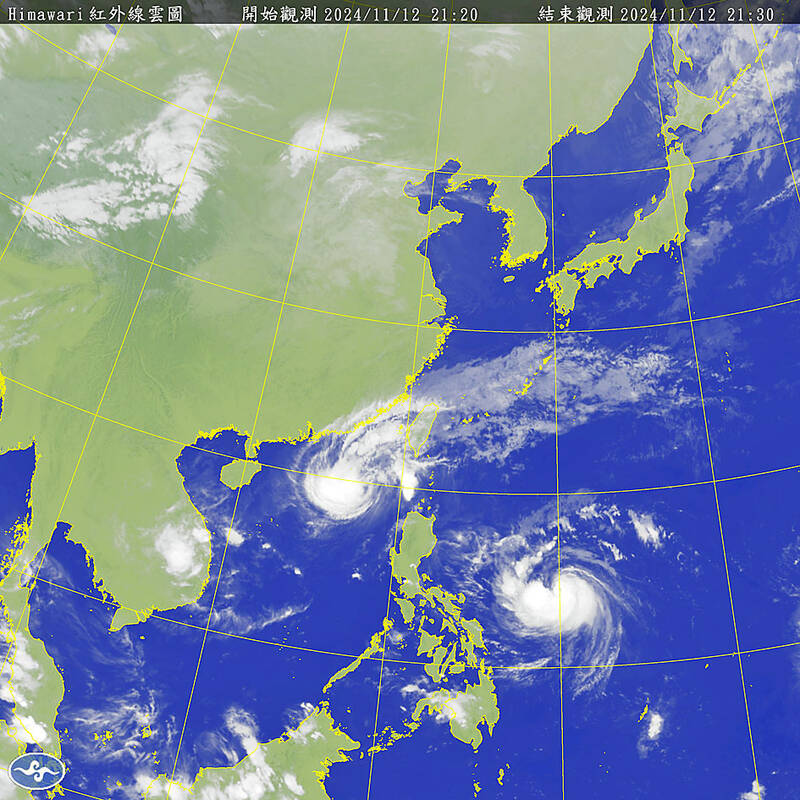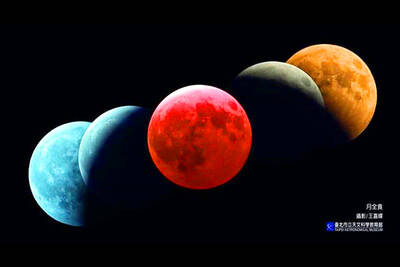The fourth tropical storm to form in the western Pacific in the past 10 days, Tropical Storm Usagi, might affect Taiwan, with sea warnings possible as early as tomorrow, the Central Weather Administration (CWA) said yesterday.
As of 8am yesterday, Usagi had a radius of 80km and was 660km northwest of the Philippines’ Yap Islands, or approximately 1,660km east-southeast of Oluanpi (鵝鑾鼻), Taiwan proper’s southernmost point, CWA data showed.
The storm was moving west-northwest at 27kph, with maximum sustained winds of 72kph and gusts reaching up to 101kph, the data showed.

Photo: Screen grab from the Central Weather Administration’s Web site
Forecasts of the storm’s path varied among countries.
On Monday evening, the CWA said that Usagi’s path was trending north of its previous projections, which could lead to sea warnings being issued for waters near Taiwan.
CWA forecaster Chen Pei-an (陳姵安) said that the storm was likely to move northward tomorrow, but she was unsure whether it would head into the South China Sea through the Bashi Channel or affect waters east of Taiwan.
As of yesterday morning, CWA data showed the storm’s projected path entering waters east of Taiwan sometime over the weekend.
The formation of Usagi marked a rare instance of four tropical storms or upper-level weather systems coexisting in the western Pacific in November.
Tropical storms Yinxing, Toraji and Manyi were not forecast to affect Taiwan. Yinxing, was weakening and was expected to dissipate soon.
The last time Taiwan’s weather agencies reported four systems at the same time was in October 1994.

Three batches of banana sauce imported from the Philippines were intercepted at the border after they were found to contain the banned industrial dye Orange G, the Food and Drug Administration (FDA) said yesterday. From today through Sept. 2 next year, all seasoning sauces from the Philippines are to be subject to the FDA’s strictest border inspection, meaning 100 percent testing for illegal dyes before entry is allowed, it said in a statement. Orange G is an industrial coloring agent that is not permitted for food use in Taiwan or internationally, said Cheng Wei-chih (鄭維智), head of the FDA’s Northern Center for

LOOKING NORTH: The base would enhance the military’s awareness of activities in the Bashi Channel, which China Coast Guard ships have been frequenting, an expert said The Philippine Navy on Thursday last week inaugurated a forward operating base in the country’s northern most province of Batanes, which at 185km from Taiwan would be strategically important in a military conflict in the Taiwan Strait. The Philippine Daily Inquirer quoted Northern Luzon Command Commander Lieutenant General Fernyl Buca as saying that the base in Mahatao would bolster the country’s northern defenses and response capabilities. The base is also a response to the “irregular presence this month of armed” of China Coast Guard vessels frequenting the Bashi Channel in the Luzon Strait just south of Taiwan, the paper reported, citing a

UNDER PRESSURE: The report cited numerous events that have happened this year to show increased coercion from China, such as military drills and legal threats The Chinese Communist Party (CCP) aims to reinforce its “one China” principle and the idea that Taiwan belongs to the People’s Republic of China by hosting celebratory events this year for the 80th anniversary of the end of World War II, the “retrocession” of Taiwan and the establishment of the UN, the Mainland Affairs Council (MAC) said in its latest report to the Legislative Yuan. Taking advantage of the significant anniversaries, Chinese officials are attempting to assert China’s sovereignty over Taiwan through interviews with international news media and cross-strait exchange events, the report said. Beijing intends to reinforce its “one China” principle

A total lunar eclipse, an astronomical event often referred to as a “blood moon,” would be visible to sky watchers in Taiwan starting just before midnight on Sunday night, the Taipei Astronomical Museum said. The phenomenon is also called “blood moon” due to the reddish-orange hue it takes on as the Earth passes directly between the sun and the moon, completely blocking direct sunlight from reaching the lunar surface. The only light is refracted by the Earth’s atmosphere, and its red wavelengths are bent toward the moon, illuminating it in a dramatic crimson light. Describing the event as the most important astronomical phenomenon